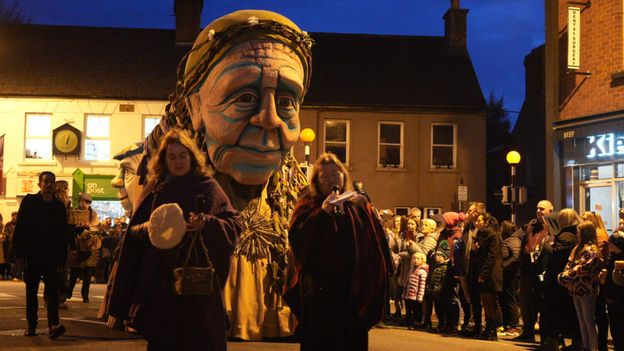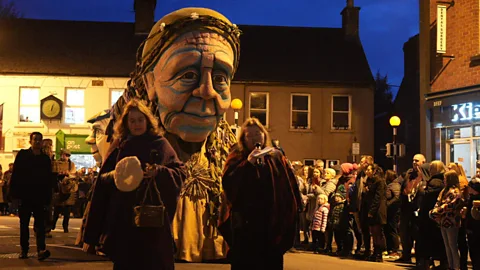 Courtesy Harris PR
Courtesy Harris PRThink Halloween, and most of us associate it with the hedonistic, multi-billion-dollar event that is seen in the US. Yet, its true origins actually lie in Celtic culture.
I didn’t expect her to be holding a decapitated head when she arrived. But there she was, standing in the foyer of the Trim Castle Hotel in County Meath, clutching the angry-looking face of a man called Áillen under her arm. It was a suitably macabre introduction for the organiser of the Púca Halloween Festival here in Ireland.
“Sorry,” said Claire Morrissey, “I’ve been busy painting him all afternoon – I’m just on my way to the workshop.”
It wasn’t a human head, of course, rather a papier mâché sculpture of a figure from Celtic folklore who, legend has it, would attend gatherings on 31 October and, using his melodic tiompán (a type of Irish harp), would lull everyone to sleep before setting the whole place on fire. This year at the festival (from 31 October to 3 November 2024), he will form part of a huge procession to the 12th-Century castle in the town of Trim, which, Morrissey tells me, will end in a pyrotechnic fire display for which everyone will be decidedly awake.
“It’s much older than people think,” said Dr Kelly Fitzgerald, head of the School of Irish, Celtic Studies and Folklore at University College Dublin. “It can be traced back thousands of years to a cross-quarter day in the Celtic calendar that is halfway between the autumn equinox and the winter solstice – known as Samhain. It was a huge celebration, so when Irish people emigrated to North America, they took their traditions with them, and over time they evolved into the Halloween we celebrate today.”
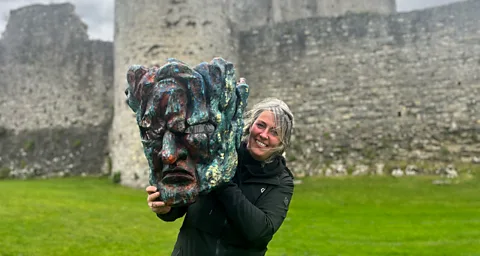 Phoebe Smith
Phoebe SmithHalloween, or Samhain (pronounced Sow-in, literally meaning “the end of summer”), was, and still is, huge in Ireland, with processions and festivals held across the entire island, from Derry to Waterford – including, since 2019, County Meath. This is when locals decided to cement their historic link to Samhain’s origins, and called their event Púca, after the shape-shifting mischievous spirit in Irish folklore.
“It’s different from Halloween in that we’re celebrating a traditional origin story,” said Púca organiser Morrissey. The four-day festival will include a parade, several music concerts, ghost tours and costume-making workshops – utilising fallen leaves and twigs rather than single-use plastic. And turnip-carving sessions will take the place of pumpkin carving, as this was the vegetable that Jack-o’-lanterns were originally made from to scare away spirits before the tradition reached North America and locals found pumpkins much easier to carve.
It sounded fun, but I was curious – what makes County Meath able to claim Samhain as its own?
“There’s a mound called the Hill of Ward above the town of Athboy where remains of large, ancient ceremonial fires were discovered in 2014, thought to be from around 500 CE,” explained Morrissey, “strongly suggesting that thousands of years ago the community would gather there on Samhain to celebrate the end of the harvest with a bonfire, marking the coming of the dark season. And afterwards, they would carry burning torches down to their homes to light their own fires to see them through the winter.”
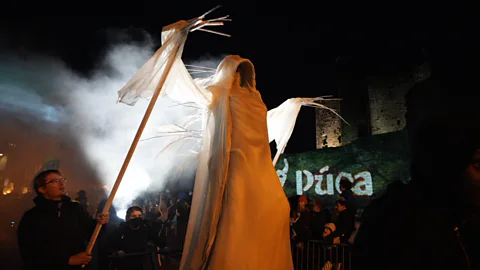 Courtesy Harris PR
Courtesy Harris PRThat excavation 10 years ago was the first to point towards a Samhain connection beyond folkloric accounts. According to Dr Steve David, the head archaeologist leading the dig, “There are very few monuments in Ireland that we consider comparable to this.” He explained that not only is the mound a massive ceremonial enclosure, but its location right in the heart of a major monumental landscape is striking, with nearly 360-degree views around it. “We have found evidence of intense burning there,” he added. “So, this monument is associated with fire and the medieval texts would associate this very strongly with an annual fire festival.”
Whether or not that festival was the very first Samhain celebration is impossible to prove, but there are other links that support County Meath’s claim as the birthplace of the celebration. For example, the original name of the hill is Tlachtga, which is the name of a Celtic sun goddess – and where the sun is mentioned, fire is implied. There are also medieval texts from 17th-Century writers specifically saying that on Halloween all other fires were extinguished to be relit from the one on Tlachtga’s summit.
Eager to see the potential birthplace of Halloween myself – and learn more about the person for whom it was named, I headed to the hill, which is just 10 minutes north of Trim. As I walked to the summit I was serenaded by robins and song thrushes hidden amid the ombre blush of red, orange and yellow leaves. My boots crunched on fallen conkers from horse chestnut trees. Seeing nature visually mark the change between summer and winter, with leaves dying and dark nights drawing in, the Samhain celebrations seemed to make perfect sense. Fitzgerald agrees that the Celts took their cues from the natural world.
“Samhain was written about in the earliest literature to come out of Ireland,” she explained. “We have the Otherworld, the world of the dead, and we have the natural world, the world of the living. And at this time when things are dying and the sun is fading, the veil between the two was said to be at its thinnest so mischievous spirits could come into our world.”
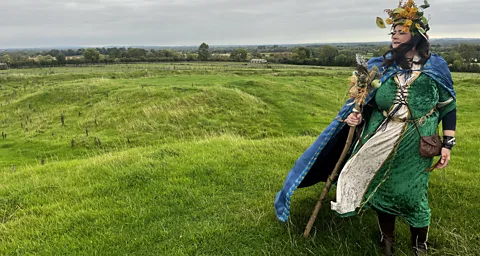 Phoebe Smith
Phoebe SmithTo protect oneself from these spirits, the practise of dressing up caught on as a disguise to keep the wearer safe, lest they be dragged into the Otherworld. Someone who takes this practice very seriously is the person I was about to meet on the hilltop: Fiona Dalton or, as she introduced herself that day, Tlachtga herself (pronounced Clock-da). She was dressed in a green and brown flowing dress, clasping a staff made from hazel and sporting a headdress of autumnal leaves and berries. She explained how she was the powerful druid and daughter of a sun god, who, legend has it, died giving birth to triplets right here on this summit. If the hill is the birthplace of Halloween, then she is – arguably – its mother.
“You may know this as the Hill of Ward but that is only since the 17th Century. Its real name is Tlachtga, named after me, and my people celebrated here every year on Samhain,” she bellowed, as I made my way over the grass-covered late Bronze Age earthworks that line its plateau. She then led me into town to the Fair Green – a community green space featuring a wood carving of Tlachtga, as well as a throne hewn from a felled tree and a circle of oak and horse chestnut trees that formed a so-called fairy fort.
This was a living history tour – the brainchild of Dalton and her partner Gerry Meade – that recounts tales from Celtic mythology to explain how they intersect with modern day Halloween in Athboy and County Meath. We ended, as all great tours do, in a pub for some lunch.
Amid the visually arresting parades and fire festivals, another important element of Samhain is the food – and I’m not talking about candies and chocolate. This time of year marked the end of the harvest and a time for feasting on the bounty of crops produced. Nowadays it sees a proliferation of barmbrack – a kind of fruited loaf – in Irish shops, as well as menus featuring colcannon (mashed potato with cabbage and a big knob of butter).
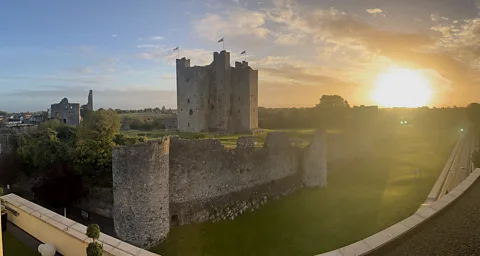 Phoebe Smith
Phoebe Smith“Halloween is often called ‘cally night’ or ‘colcannon night’,” explained Regina Spector, food and culinary historian at University College Cork, whom I met later that day to ask about the importance of food. “It was a key part of Samhain feasting – being warming and a real treat because of all the butter. But at this time of year, food has a different function outside of feasting – to connect communities together through games and activities.”
Apples, she explained, were traditionally peeled so the skin could be thrown to reveal the initial of a future suitor, or bobbed in water for in a matchmaking ritual. The barmbrack is an easy-to-make bread made special by seasonal fruit and nuts, with symbolic items – a ring for marriage, a cloth for poverty, a thimble for spinsterhood or a matchstick for an argument – folded in by the baker. A practise that, due to health and safety, is not nearly as widespread today.
Filled up with comfort food (minus the foretelling of my future), I continued on my hunt for links to Halloween in County Meath among its ancient and mystical sites. At the imposing Trim Castle and the crumbling ruins of St Mary’s bell tower on the opposite banks of the River Boyne, I undertook a ghost tour with local Cynthia Simonet, who regaled me with modern stories of an alleyway haunted by a monk, and Celtic legends of the Cú Sidhe – a black dog that can go from this world to the Otherworld. Almost in a whisper, she told me how “about 20 odd years ago, rumours started to circulate that there [were] white witches out in Athboy holding ceremonies at Halloween on the summit of Tlachtga”, thus cementing a strong belief of its claim to the origins of Samhain.
Next was an exploration of the county’s myriad Neolithic sites, including Newgrange (a 5,000-year-old passage tomb) and Knowth (an ancient burial ground with the largest collection of engraved megalithic art in the world). On the surface, both have no link to Halloween’s origins as they predate the Celtic beliefs. Yet the former is said to be the gateway to the Otherworld, and the latter has a series of standing stones; and one of these, my guide informed me, casts a shadow that points towards the tomb’s inner sanctum – at sunrise after Samhain evening on 31 October.
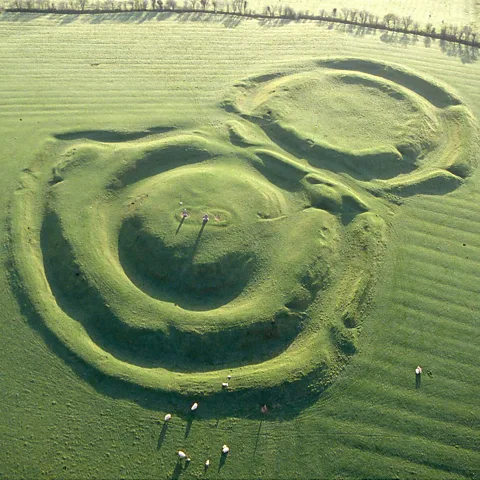 Government of Ireland National Monuments Service Photographic Unit
Government of Ireland National Monuments Service Photographic UnitFinally I journeyed to the Hill of Tara (known famously as the seat of the High Kings of Ireland), whose Stone Age “Mound of Hostages” also has a passageway that, every year, is illuminated by the rising sun at… Samhain.
I left with multiple yarns of history and folklore spinning in my head, and attempted to weave them all together. Some historians and archaeologists point out that the links between Samhain and the area are difficult to prove conclusively, but there are certainly a lot of handy coincidences. And the one thing that does tie Samhain, Halloween and now Púca together here in County Meath, I realised, is their ability to bring people and communities together. Perhaps that’s something we can all embrace as the nights darken, the leaves fall and we all try not to lose our heads.

